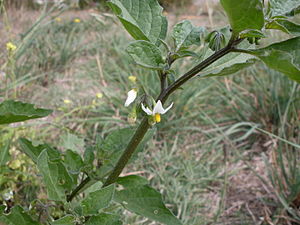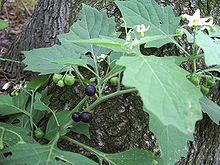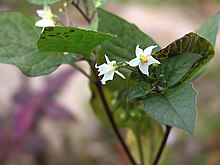Black nightshade
| Black nightshade | ||||||||||||
|---|---|---|---|---|---|---|---|---|---|---|---|---|

Black nightshade ( Solanum nigrum ) |
||||||||||||
| Systematics | ||||||||||||
|
||||||||||||
| Scientific name | ||||||||||||
| Solanum nigrum | ||||||||||||
| L. |
The Solanum nigrum or black nightshade ( Solanum nigrum ) is a flowering plant from the genus of the nightshade ( Solanum ), which spread almost worldwide and frequently as Ruderalpflanze be found.
description
Vegetative characteristics
The black nightshade is an annual , herbaceous plant that can usually be up to 70 cm high and grows prostrate to upright. The surface of all parts of the plant can be hairy to tomentose, the trichomes are simple, multicellular hairs with glandular or non-glandular heads. The stems also do not lignify at the base, are not or only slightly angular, often overgrown with black.
The strikingly dark green colored leaves are between 2.5 and 7.0 cm long and between 2.0 and 4.5 cm - rarely up to 6.0 cm - wide. They are egg-shaped, egg-shaped-lanceolate, egg-shaped-rhombic or lanceolate in shape, the leaf margin is serrated all over to curved. They stand on 2 to 5 cm long, twisting petioles.
The roots have oligarchic vascular bundles with small-lumen vessels. The endodermis is not clearly differentiated.
Inflorescences and flowers
The bloom time of the black nightshade extends from June to October. The inflorescences sit in the axils of the middle to upper leaves. They are simple, loose, often elongated umbels of usually five to ten, more rarely only three flowers . The inflorescence stalks have a length of 14 to 28 mm, rarely they have a length of 8 mm. The flower stalks are significantly shorter and bend back as the fruit develops. The bell-shaped calyx is 1.2 to 2.5 mm long and consists of mostly egg-shaped sepals. As the fruit ripens, it enlarges slightly, bends back or rests against the fruit. The star-shaped corolla consists of five white petals, which are fused together at the base up to half their length and become translucent towards the center of the flower. The crown has a diameter of 5 to 7 mm, with extreme values between 4 and 9 mm. It is 1.5 to 3 times the length of the calyx. The five stamens fixed to the base of the crown are yellow, 1.5 to 2.5 mm, rarely up to 2.8 mm long. The anthers, which are arranged inclined, are densely hairy and open with holes, accompanied by a gap along the longitudinal axis. The pollen grains are about 29.5 to 33.9 µm in diameter. The pen is about 2.8 mm to 3.5 or rarely up to 4.5 mm long and is not beyond the stamens. Typical pollinators of the black nightshade are hover flies (Syrphidae), bees ( Apis ) and bumblebees ( Bombus ).
Fruits and seeds
The fruits are 6 to 10 mm large, broadly egg-shaped berries with two chambers and a juicy pericarp without stone cells , the color of which varies between matt purple, black and yellowish-green. Each berry usually contains between 26 and 60 seeds, but extreme values are between 15 and 96. The flattened seeds are 1.7 to 2.4 mm long. The embryo is strongly helical, the cotyledons are shorter than the rest of the embryo, the endosperm is abundant.
The number of chromosomes is 2n = 40.
ingredients
Due to the high content of alkaloids , especially in the unripe berries, the plant is often categorized as a poisonous plant, however ripe berries and the leaves are used as vegetables in some parts of the world. All parts of the black nightshade contain the glyco alkaloids attributed to steroid alkaloids solanine , Solasonine , solamargine and chaconine . The concentration of these substances fluctuates very strongly and is probably dependent on the climate and type of soil in which the plant grows, and the concentration decreases with increasing age of the plant. This explains why there is a great deal of evidence that either categorizes the plant as a poisonous plant or describes its use as a food.
Distribution and locations
The range of the species includes all of Europe , large parts of Africa , the Middle East , India , China , Australia , New Zealand and North America . The geographical origins of the species could not yet be precisely determined. It is assumed, however, that these are in the Eurasian area , as there is a very good adaptation to the conditions in the Mediterranean area. Other possible areas of origin are the Middle East, India or Africa. In North America, Australia and New Zealand the black nightshade is one of the introduced plant species.
The locations of the black nightshade are between 0 and 3000 meters above sea level. The species is very well adapted to different environmental conditions, but cannot survive longer dry periods. Often the plants can be found on roadsides, embankments, hedges, on the edge of agricultural areas, bodies of water and rubbish dumps as well as in the vicinity of built-up areas.
The plants are not frost-tolerant, daytime temperatures between 20 and 30 ° C offer the best conditions for growth, growth is severely restricted at temperatures below 15 ° C and above 35 ° C. The best light conditions for growth exist with a photoperiod of 16 hours, the fruit set is significantly restricted by shading, while the vegetative growth of the leaves is only slightly influenced.
Systematics
Botanical history

The Roman scholar Pliny the Elder , who lived in the first century, mentioned the species in his writings, as did many later botanists, including Dioscurides .
A first known taxonomic study of the black nightshade and related species comes from Johann Jacob Dillen , who described four different taxa in 1732. The first botanical description of the black nightshade was made in 1753 by Carl von Linné in his work " Species Plantarum " , in which a total of six varieties were summarized under the name Solanum nigrum . In 1974 the specimen referred to by Linné in his herbarium as entry 248.18 was established as the lectotype of the species. This means that it belongs to the subspecies Solanum nigrum subsp. nigrum belonging, plant both lectotype of the genus of the nightshade ( Solanum ), the family of the nightshade family (Solanaceae) and the order of the nightshade-like (Solanales).
It was only during the revision of the Solanum section for Flora Europaea Volume 3, published in 1972 , that it emerged that two different forms of the species exist in parallel in Europe. The most common form was known as the subspecies Solanum nigrum subsp. nigrum , the second, less common species than Solanum nigrum subsp. schultesii classified.
External system
Within the genus Solanum , the species is classified in the Solanum section , which is sometimes referred to as the Morella section or the Solanum nigrum complex. The species in this section form a polyploid series, with diploid (2n = 2x = 24), tetraploid (2n = 4x = 48) and hexaploid (2n = 6x = 72) representatives; octoploidy is also known from two reports. Solanum nigrum is hexaploid, while the former Solanum americanum and Solanum scabrum , which were often also included in the species, are diploid and hexaploid, respectively.
|
|
|
||||||||||||||||||||||||
|
|
According to the cladogram
At a higher level, the section is classified by the classical system in the subgenus Solanum , phylogenetic studies place the section in the Morelloid clade.
Internal system
Two subspecies are distinguished within the species:
- Solanum nigrum L. subsp. nigrum
- Solanum nigrum L. subsp. schultesii (Opiz) Wessely
The former can be found in the entire range of the species and is characterized by low hairiness with adjacent, non-glandular, multicellular trichomes. The second subspecies is found only in the drier areas of Central, Southern and Eastern Europe, as well as on the Australian continent southeast of Adelaide . It has more tomentose hairs with upright, rarely lying, multicellular trichomes, which have glandular tips and occur in different lengths.
Molecular biological studies based on AFLP data could not confirm the morphologically justified division of the species. However, since these investigations were only carried out with relatively few representatives of the two subspecies, no taxonomic conclusions can yet be drawn.
use
food
Although there are numerous reports of poisoning from the consumption of parts of plants of the black nightshade, there is also a large amount of evidence of its use as food. On the one hand the leaves are used as spinach- like vegetables, on the other hand the ripe berries are eaten as fruit. It is often reported that the leaves are boiled, with the cooking water being changed several times or replaced with milk to prevent possible poisoning. A preparation variant from Malawi includes the addition of vegetable potash or sodium carbonate , peanut butter and salt. According to a popular belief in Kenya , newborns whose mothers ate boiled nightshade leaves while pregnant have particularly dark eyes and smooth skin.
The ripe fruits are mainly eaten in parts of Africa, but also in North America, India and China, Russia and Kazakhstan. In North America, the fruit is also known as "Wonderberry" and is used to make jam .
Medicine
Medical uses of the black nightshade are known from many cultures. The herb collected and dried during the flowering period is used in folk medicine as a medicine against stomach and bladder cramps and whooping cough, external use is recommended for eczema, weeping lichen, itching, hemorrhoids, cracks, bruises and abscesses.
According to African folk medicine, children who eat black nightshade as a vegetable should be spared diseases such as marasmus and kwashiorkor .
Poisonous plant
Poisoning is repeatedly described due to the occurrence of solanine and other alkaloids, especially in the unripe fruits. In small children, the actually low solanine content of ripe fruits is sometimes sufficient to cause symptoms of poisoning. Symptoms can include vomiting, diarrhea, difficulty breathing, increased heart rate, and kidney irritation. In addition, anxiety, cramps and paralysis occur, as well as an increase in body temperature with a subsequent drop below normal. With severe poisoning, death occurs through paralysis of the central respiratory system.
Since some chickens perish after eating poisonous, unripe berries, the name Hühnertod has become established for the species. Poisoning by grazing animals can also be attributed to the high nitrate content of the plants. If this is the case, the milk of affected animals tastes bitter.
In Germany, the Cosmetics Ordinance prohibits the use of Solanum nigrum and its preparations for the manufacture and treatment of cosmetic substances due to their toxicity.
etymology
The name Nightshade ( Old High German nahtscato , Middle High German seamschade or seamschate ), which is used today as the generic name of the Solanum , originally primarily referred to the type of black nightshade (also the bittersweet nightshade , Solanum dulcamara ) and is also found in older texts in the Form nightshade . The origin of the name is uncertain, on the one hand it can be traced back to the black berries of the plant, on the other hand to the effect of the plant (shadow meaning damage).
Reinterpretations of the term nightshade are often used as additional, locally used names, such as Nachtschaat, Nachtigaal and day and night herbs. The names Krällekesdreck, Inkberry, Tenteknerzcher and Schwartebobbelkrut derive from the shape and color of the berries, from the toxicity the names poisonous bloom, poisonous herb, poisonous berry, devil's herb, Düvelskiesche, Deiwelskersche, Teufelsdreck, devil's claw, Juddekerschhnert, catberry, saukraut , Schitbeeren, Scheißkraut and many others. The name Morelle herb is borrowed from the French morelle . Furthermore, the names alpine herb, wild potato, Poschitschkberry and barbel herb are also listed as names for the black nightshade.
Individual evidence
- ↑ a b c d e f g h i j Jennifer M. Edmonds, James A. Chweya: Black Nightshades - Solanum nigrum L. and related species (PDF; 2.8 MB) . International Plant Genetic Resources Institute, Rome, Italy 1997, ISBN 92-9043-321-3 .
- ↑ a b Dietmar Aichele, Heinz-Werner Schwegler: The flowering plants of Central Europe. Volume 4: nightshade plants to daisy plants . Franckh-Kosmos, Stuttgart 1995, ISBN 3-440-06194-9 .
- ↑ Zhang Zhi-yun, Lu An-ming, William G. D'Arcy: Solanum. In: Wu Zheng-yi, Peter H. Raven (Ed.): Flora of China . tape 17 : Verbenaceae through Solanaceae . Science Press / Missouri Botanical Garden Press, Beijing / St. Louis 1994, ISBN 0-915279-24-X , pp. 314-325 (English).
- ↑ FN Mbagwu, CU Nwachukwu, OO Okoro: Root Anatomical Studies On Salanum Macrocarpum and Solanum Nigrum (Solanaceae). In: Journal of American Science. Volume 3, No. 3, 2007, pp. 1-4, PDF file.
- ↑ a b Armando T. Hunziker: Genera Solanacearum: the genera of Solanaceae illustrated, arranged according to a new system. ARG Gantner, Ruggell / Liechtenstein 2001, ISBN 3-904144-77-4 .
- ↑ DE Symon: Sex forms in Solanum (Solanaceae) and the role of pollen collecting insects. In: JG Hawkes, RN Lester, AD Skelding (Eds.): The Biology and Taxonomy of the Solanaceae . In: Linnean Society symposium series. Volume 7, Academic Press, London 1979, ISBN 0-12-333150-1 , pp. 385-397.
- ↑ BiolFlor search system. Accessed January 24, 2020 .
- ↑ Carl von Linné : Species Plantarum . Volume 1, Impensis Laurentii Salvii, Holmiae 1753, p. 186, digitized .
- ↑ The Linnaean Plant Name typification Project: Solanum nigrum . Natural Museum of History, London. Online, accessed September 2, 2007.
- ↑ a b Klaus J. Dehmer, Karl Hammer: Taxonomic status and geographic provenance of germplasm accessions in the Solanum nigrum L. complex: AFLP data. In: Genetic Resources and Crop Evolution. Volume 51, No. 5, 2004, pp. 551-558, doi : 10.1023 / B: GRES.0000024163.86762.fc .
- ↑ Lynn Bohs: Major Clades in Solanum based on ndhF Sequence Data. In: Richard C. Keating, Victoria C. Hollowell, Thomas B. Croat (Eds.): Festschrift for William G. D'Arcy: The Legacy of a Taxonomist. In: Monographs in Systematic Botany from the Missouri Botanical Garden. Volume 104, 2005, pp. 27-49.
- ↑ Shiu-ying Hu: Food Plants of China . The Chinese University Press, Hong Kong 2005. ISBN 962-201-860-2 .
- ↑ Gerhard Habermehl, Petra Ziemer: Central European poisonous plants and their active ingredients. 2nd expanded edition, Springer Verlag, Berlin 1999, ISBN 3-540-64810-0 .
- ↑ Jürgen Martin: The 'Ulmer Wundarznei'. Introduction - Text - Glossary on a monument to German specialist prose from the 15th century. Königshausen & Neumann, Würzburg 1991 (= Würzburg medical-historical research. Volume 52), ISBN 3-88479-801-4 (also medical dissertation Würzburg 1990), p. 154 ( seamschate ).
- ^ Heinrich Marzell, Heinz Paul: Dictionary of German Plant Names . Licensed edition Parkland Verlag, Cologne, 2000. Photomechanical reprint of the first edition, 1979. ISBN 3-88059-982-3 .
Web links
- Black nightshade. In: FloraWeb.de.
- Black nightshade . In: BiolFlor, the database of biological-ecological characteristics of the flora of Germany.
- Solanum nigrum L. In: Info Flora , the national data and information center for Swiss flora .
- Distribution in the northern hemisphere from: Eric Hultén, Magnus Fries: Atlas of North European vascular plants. 1986, ISBN 3-87429-263-0 at Den virtuella floran. (swed.)
- Thomas Meyer: Nightshade data sheet with identification key and photos at Flora-de: Flora von Deutschland (old name of the website: Flowers in Swabia )
- American Nightshade: A Much Maligned Edible (in English, with a detailed description of the use of the black nightshade (Solanum nigrum) for human consumption)







